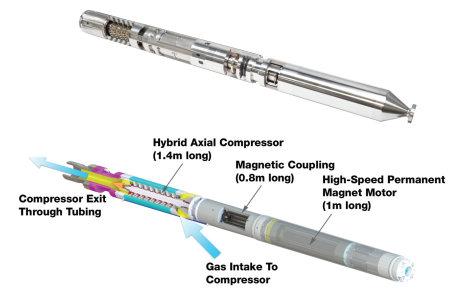
5 minute read
Addressing the issue of liquid loading
Upwing Energy outlines its new subsurface artificial lift technology which alleviates liquid loading and extends productive well life.
NATURAL GAS PRODUCERS in the Middle East are growing increasingly concerned about the persistent problem of liquid loading, which is negatively affecting productivity. Accumulation of liquids in the well creates blockages and backpressure that reduces gas velocity, causing a falloff in production and potentially leading to premature abandonment.
Various artificial lift solutions, such as surface compressors and electric submersible pumps (ESPs), have been employed to remove liquids and increase production with less than satisfactory results. A promising new patented downhole artificial lift technology has been developed and demonstrated by Upwing Energy, a US-based technology and service company. Upwing’s subsurface compressor system (SCS) is based on advanced high-speed magnetic technologies. According to Upwing’s CEO Herman Artinian, the Upwing SCS has been designed to provide reliable performance in the downhole environment by eliminating the common points of failure in conventional ESPs.
Artinian explains that the hermetically sealed downhole tool consists of a highspeed permanent magnet (PM) motor, a shaftless magnetic coupling between the motor and compressor, and passive noncontact magnetic bearings with electronic dampers. The hybrid axial wet-gas compressor is driven by the high-speed PM motor. Torque is conveyed from the motor to the compressor with no mechanical shaft or seals, eliminating the need for a motor protector to isolate the motor from downhole fluids. This “protector-less” architecture, according to Artinian, eliminates a frequent source of vulnerability for conventional downhole artificial lift systems.
The system also includes a sensorless wide-frequency variable speed drive (VSD) at the surface that controls the downhole motor at speeds of up to 50,000 rpm.
The Upwing SCS lowers the bottomhole well pressure, increasing the velocity of the gas stream, removing liquids from the vertical and horizontal sections of the well. The lowered backpressure from liquid loading increases gas production, which in turn accelerates liquid unloading. Once the liquid is carried upward by the gas stream, the lower pressure at the compressor intake and the higher temperature at the compressor discharge prevents vapour condensation and enhances the carry-over of liquids to the surface by the gas stream.
“Upwing’s unique downhole turbomachinery can maximise gas and condensate production, recoverable reserves, gas-in-place recovery efficiency and liquid unloading at the same time,” says Artinian. “All of these benefits can be realised in any type of formation and wellbore geometry in both the onshore and offshore environments regardless of where the well is within its life span.”
Modelling tools make it possible to evaluate and predict the outcome of conventional wells with the SCS. This is due to better understanding of the conventional reservoir, existing verified models and available historical data. Operators can insert the SCS compressor maps into their reservoir models and verify the incremental improvement in production and recoverability.
As Upwing continues with its trials, the results are being verified with comprehensive inhouse models that incorporate the SCS tool, reservoir, wellbore and top-side equipment. For conventional reservoirs, these modeling tools can predict results fairly closely. SCS gas well simulations and trials have shown gas production increases ranging from 20 to more than 200% and increased recoverable reserves ranging from 20 to more than 70%.
“It is significantly more cost effective to increase production and reserves of existing conventional wells than drilling new unconventional ones,” says Artinian. “Using simulation modeling tools developed by Upwing Energy, we have demonstrated that reducing liquid loading with the SCS to extend the life of a conventional liquid loaded well would require 96% less capital expenditure than drilling a new unconventional well, and produce 28% more gas and condensate within the initial 10 years.”
Upwing Energy has experienced significant interest from the Middle East, North Africa and Southeast Asia, where most of the gas wells are starting to face liquid loading issues, and is working on putting together trials in these regions. n
Image Credit : Upwing Energy
Upwing’s subsurface compressor system (SCS) is based on advanced high-speed magnetic technologies.

Automation making
multi-sector appeal
Automation helps the oil and gas workforce to work faster and helps asset owners save time and money without compromising safety. Organisations are increasingly looking to deploy automation to improve their operational performance and make vital efficiency gains.
AUTOMATION OF ENERGY technology is important for mastering the future challenges of sustainable energy supply. It is already being established across oil and gas operations, and some of the latest technologies and collaborations are helping operators with highly specific tasks in sectors and subsectors.
For example, in a recent move to deploy workflow automation software that is specifically tailored to the requirement of the oil and gas industry, Petrofac has signed a three-year partnership with Intoware. The development of ‘WorkfloPlus Oil and Gas’ will further optimise the efficiencies that Petrofac has gained from digitalising maintenance and inspection activity for its clients. The software has been designed to automatically generate digital workflows, schedules and reports for users, eliminating the traditional manual and timeconsuming preparation required.
Steve Johnson, vice-president of digital for Petrofac’s Engineering and Production Services business, commented, “The tool empowers teams to work faster and more efficiently, ultimately saving asset owners time and money without comprising safety.”
Honeywell technology plays a major role in providing automation solutions in large petrochemical complexes. In February 2021, in North Africa, Sidi Kerir Petrochemicals Company (SIDPEC) selected Honeywell technology to upgrade the production capabilities of its flagship petrochemical complex in Alexandria, which produces ethylene and polyethylene for the Egyptian market. Honeywell has replaced SIDPEC’s legacy Honeywell TotalPlant Solution (TPS) production system with the latest version of its Experion Process Knowledge System solution at SIDPEC’s complex in Alexandria.
Also, Anchorage Investments Ltd will use Honeywell UOP’s C3 Oleflex technology to produce 750,000 mt per year of polymergrade propylene for its new Anchor Benitoite petrochemicals complex in Suez, Egypt, near the southern terminus of the Suez Canal. Honeywell UOP’s C3 Oleflex technology converts propane to propylene through catalytic dehydrogenation. The technology is designed to have a lower cash cost of production and higher return on investment when compared to competing dehydrogenation technologies.
It is not just all about the strategic collaborations – companies are developing sophisticated technologies too. The latest on the list is Emerson’s Rosemount TankMaster Mobile – the world’s first cross-platform inventory management software application for tank gauging systems – providing immediate secure access to critical tank data. By making real-time data available to a wider range of stakeholders via smartphones, tablets and computers, this easy-to-use mobile solution facilitates better decision-making and improved operational efficiency and safety.
Per Skogberg, solutions manager with Emerson’s Automation Solutions business, said, “By facilitating secure mobile access to this information, Rosemount TankMaster Mobile provides the opportunity to increase efficiency, drive productivity and improve collaboration throughout the supply chain.” n











